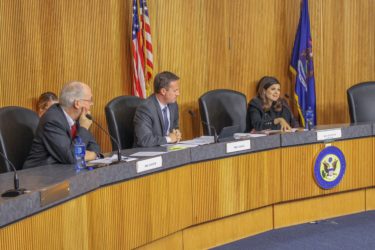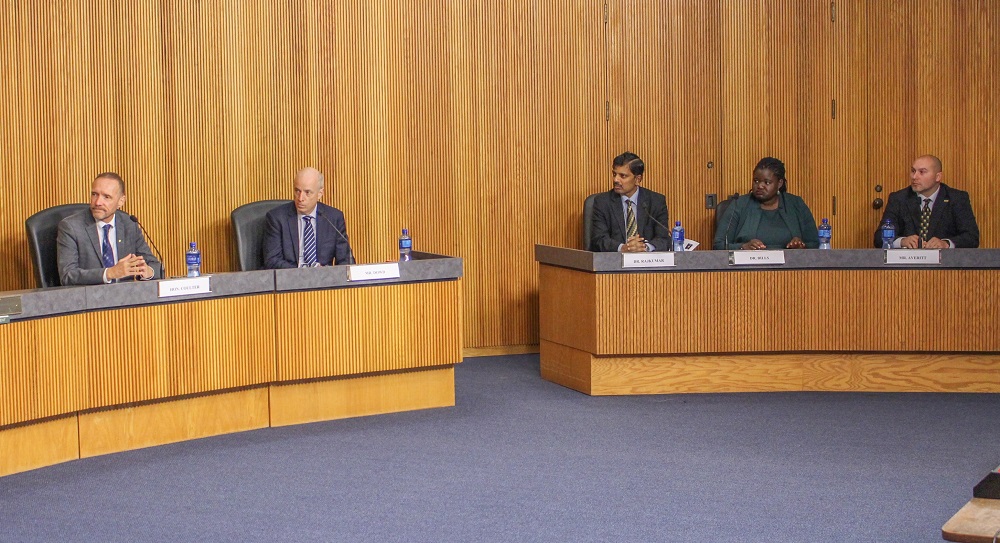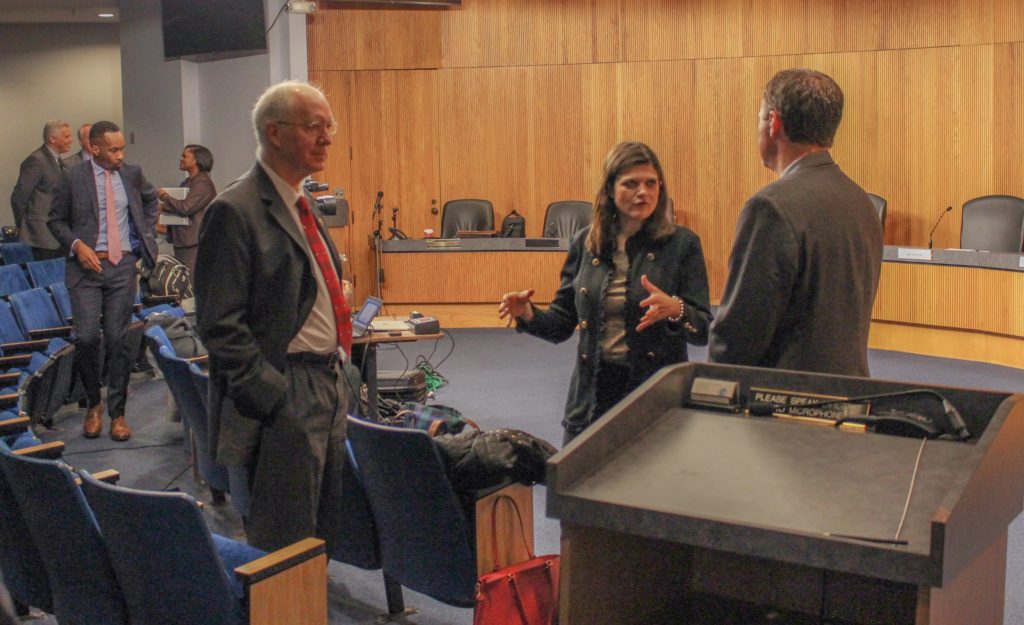Smart mobility at the local level

Oct. 25, 2019, Livonia, Mich.
It’s one thing to consider the innovative technology that will turn gas-guzzling vehicles into cleaner electric cars with autonomous capability eventually connected to a smart city infrastructure.
It’s another to think about why we’re doing it. It’s easy to get lost in the excitement of possibility, but let’s not lose sight of why it matters and who it can benefit, or even hurt.
On October 25, 2019, Representative Haley Stevens of Michigan’s 11th District hosted Smart Mobility: It’s a Community Issue — a field hearing to discuss the future of connected and autonomous driving capabilities. Stevens, along with Representative Michael Cloud of Texas’s 27th District, addressed their concerns and took the opportunity to ask questions to a panel of five experts.

Here are some of the topics discussed during the 90-minute hearing.
The social impact of smart mobility
Dr. Tierra Bills, an assistant professor in the civil and environmental engineering department at Wayne State University, recognized the significant impacts smart mobility could have, including a reduction in traffic incidents and delays. However, few efforts seem to focus on the potential detriments to disadvantaged communities, such as a decline in employment opportunities due to automation and lack of access to new forms of mobility.
Solutions must encompass the broadest set of needs so you don’t neglect those who may use the mass transportation aspect of autonomy the most. Bills recommends focusing on predicting resident demands and how smart mobility solutions can empower community-based decisions and ensure greater accessibility to employment, education and healthcare.
Citizens in urban, suburban and rural communities rely on the transportation infrastructure to go to work, to attend school, to keep medical appointments, run errands and travel to recreational activities. But, according to the Texas A&M Transportation Institute, the rural transit system in Texas faces an increasing demand from a growing population of older and disabled residents. These men and women are impeded by long travel distances to medical care and social services.
On top of that, an FCC Broadband Progress Report discovered that 10 percent of those in the U.S., which includes 39 percent of those in rural areas lack access to 25 Mbps/3 Mbps service; a severe hindrance when trying to advance smart mobility nationwide in areas where citizens may need these services the most.
Updating infrastructure
Representative Cloud indicated in his opening statement that the importance of addressing the nation’s aging infrastructure and how enhanced safety features and wireless communication between vehicles can benefit every community from rural Texas to suburban Detroit.
But these two areas differ dramatically. With no two communities being the same, it’s important to address community needs on the individual level, similar to customization demands that companies expect when dealing with their supplier.
Communities in proximity can work together, though, while also collaborating with local universities to gain better insight on what technology and innovations are available and figuring out the needs versus the wants, and what will have the most positive impact going forward. As larger cities implement smart mobility solutions, they can pass this critical knowledge to their suburban and rural counterparts, helping them as opposed to reinventing the wheel.
On I-75 in Oakland County, just north of Detroit, the Michigan Department of Transportation has been fixing and installing smart technology mobility infrastructure so cars can receive real-time information. Along with driver improvements, automotive companies will use this stretch of I-75 as a testbed for smart mobility technology.
Another local addition to updating aging infrastructure is the placement of roadside units along Woodward Avenue from downtown Detroit to Pontiac (approximately 20 miles of roadway). These units provide drivers with real-time traffic information, performing green light prioritization to move traffic through an intersection and offer a safety message network, thus alerting drivers to traffic threats like vehicles approaching an intersection at a high rate of speed.
Another localized success story is in Greene County. This southwestern Pennsylvania county is 90 percent rural and is currently a testbed for smart mobility innovation that could be replicated in rural counties across the U.S.
“The Greene County Commissioners are so pleased to see the collaboration between Carnegie Mellon University, Waynesburg University, and the County of Greene,” say’s Chairman Blair Zimmerman of the Greene County Board of Commissioners.
Funding is lacking
Regardless of the success stories, the large-scale implementation of transport systems won’t happen without federal help. Federal agencies can serve as a catalyst in helping major infrastructure deployment because it provides an opportunity that wouldn’t exist otherwise. A lot of the technology exists today, but the challenge is deploying it into the community.
On top of that, seeing the impact is hard. Once deployed, you must have the technology and implementation doing what it’s supposed to do; that’s another area where funding is lacking. It’s also the problem of communities employing what’s needed and being accountable when the results aren’t as apparent as the more “good looking” improvements may show.
According to Mark Dowd, executive director at Smart Cities Lab, “The current rate in which communities and universities are being funded on mobility is not good. There was an Automated Driving System Grant put out by the Department of Transportation for $60 million that was way short in funding. In Texas, two applications were submitted, but there was no money to support it. It’s unfortunate that where automation is going that we don’t have enough funding in the system.”
Boosting smart mobility nationwide might need a legislative push similar to the Rural Electrification Act of 1936. In 1930, only 10 percent of farms had access to electricity. Within 25 years, that number was at 90 percent.
When pressed for timelines on 50 percent adoption of electric vehicles, autonomous vehicles and smart cities, many of the experts at the field hearing offered a series of answers dependent on the definition.
One answer was clear. Smart mobility is an ambitious decades-long process like farm electrification and with more grant money, the federal government can provide seed money to create jobs.
Partnering up
The smart mobility market is poised to be a multi-trillion-dollar market. Because of global competition, the U.S. must invest substantially to meet technological and global competition from advancing countries like Germany, Japan, China and Korea.
Communities and local universities make for ideal partnerships. However, looking to the private sector offers monumental benefits as well. Not all private sector companies make good partners. It’s important to find a company that will work with a community as oppose to simply trying to sell them something.
Global companies can put their competencies anywhere, and they are focusing on where the talent is coming from. Unfortunately, the employment gap in the U.S. is making job creation difficult amid the lack of a reliable talent pool.
The government can create effective policy to ensure mass adoption. This includes offering federal research programs that focus on building the talent pipeline that can help encourage and expand smart city innovation and mobile development. It’s crucial to prepare the workforce for the realities of an automated future.
The United States has an impressive and robust transportation sector. Still, as smart mobility continues to advance, there is a real chance that the lack of smart infrastructure adoption could hinder the quality electric of life of those in urban, suburban and rural settings.

Why we innovate
Perhaps the greatest reason to innovate and adopt smart mobility is safety.
Representative Stevens cited in her opening statement a recent study by the National Highway Traffic Safety that announced that overall highway fatalities decreased by 2.4 percent in 2018. However, that still means that nearly 40,000 people lost their lives on our roadways. The same report showed that pedestrian fatalities increased by 3.4 percent and bicyclists’ fatalities increased by 6.3 percent.
And David Coulter, Oakland County Executive, stated in his opening statement, “I believe these new technologies can reduce deaths by 94 percent.”
What was stunning about the field hearing was how experts in their respective fields viewed the potentials of smart mobility and how crucial it is to improve our infrastructure for it to succeed. Across the board, it is widely believed that smart mobility can provide a multitude of benefits such as greater access to disadvantage people in urban, suburban and rural settings and significant reduction in traffic fatalities.
Today meets tomorrow at the local levels in communities across the United States where innovative advances in smart mobility continue. With greater help from the federal government, smart mobility can enhance our infrastructure, create jobs and connect the country, just as rural electrification and the national highway system did decades ago.
View the field hearing in its entirety:


